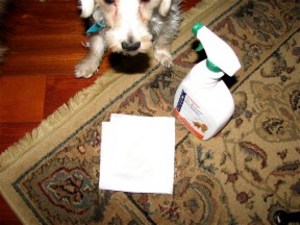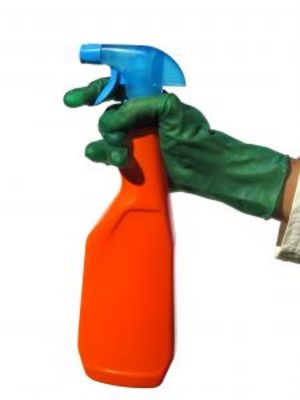“You know your dog better than anyone else,” says Dr. Kevin Fitzgerald, PhD, DVM, “and you should always be attentive to eating and drinking habits.” Often the first sign of a bladder problem in a dog will be increased thirst and urination. The dog may strain and only pass a few drops of urine, and there may be drops of blood in it. Bladder problems are more common in female dogs because of their anatomy, but male dogs occasionally suffer from them also.
For me, the first sign that there was something wrong with my dog was the sudden start of “accidents” in the house. Zelda, who had been housetrained for years, began leaving wet spots on the carpeting, no matter how many times we took her out. So it was off to the veterinarian.
“The problem,” said Dr. Fitzgerald, “is that you have to do some testing to determine what is going on.” He indicates that the first step is a urinalysis. This test will reveal the presence of protein, blood cells, bacteria or crystals in the dog’s urine. Bacteria and blood can point toward infection. Diabetes may also cause excessive thirst and urination, and a urinalysis will reveal that. In an older dog, especially one with other health problems, a tumor can be the culprit. A dog with crystals in its urine is most likely producing bladder stones, and additional tests, such as x-rays, ultrasounds and even CAT-scans may be required to detect them.
Zelda’s first urinalysis did reveal a pretty well developed infection. According to Dr. Fitzgerald, veterinarians, like Zelda’s, will prescribe a broad-spectrum antibiotic. These are antibiotics that pass through the digestive system relatively untouched and can act on the infectious agent in the bladder. But after a few days, she was still urinating on the carpet. When I took her out, I began to observe her more closely, and noticed that while she was attempting to urinate numerous times, she was passing only small amounts. When the spots in house seemed to contain blood, I took her back in to the vet.
This time, Zelda was x-rayed, and immediately it was obvious that she had bladder stones, with at least two being quite large. Apparently, this is not unusual, and in most cases, stones are not diagnosed until they are sizable, and therefore must be removed through surgery. Zelda was scheduled for surgery the next day. The operation not only revealed two large stones, each one about 2 inches across, but also about 35 smaller stones, laying in her bladder like gravel and taking up most of the space.
Once the stones were removed, they were analyzed for chemical composition. This is an important step because dogs that produce stones will be prone to produce them again, unless they are kept on a strict diet that doesn’t include the stone-causing substances. For Zelda, the result of the test showed that, for the rest of her life, she needs to be on a protein-restricted diet, which includes a prescription dog food and large quantities of water.
“Owners must be aggressive,” says Dr. Fitzgerald, “in making sure they follow their veterinarian’s instructions.” Antibiotics should be finished, and additional urinalysis should be done to make sure an infection is cured. After recovering from surgery for a tumor or stones, and dog must be watched for re-occurrences of the problem. If the dog has been prescribed a special diet, owners need to comply with that, in order to prevent additional stones.
Bladder problems in dogs cannot be taken care of by home remedies. Stones and tumors can block the urethra, causing the bladder to fill and eventually burst. Infection can spread to other parts of the body. Left untreated, bladder problems can become life threatening for your pet, so get them to your veterinarian as soon as you suspect a problem.
So far, by following her dietary restrictions, Zelda had had no recurrence of her bladder stones and is no longer having “accidents” in the house.





